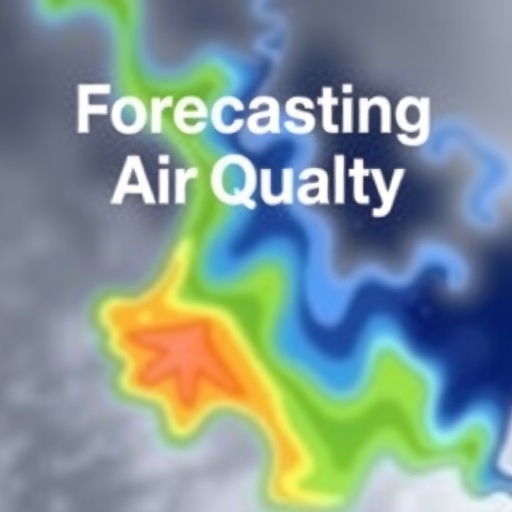Recent advancements in machine learning have sparked a surge of interest in environmental science, particularly in how it relates to air quality predictions. The quest for cleaner air has become a pivotal challenge in urban development, especially in rapidly industrializing nations like India. In a groundbreaking study, researchers S. Lawrence and S. Bhathmanabhan have set out to refine our understanding of air quality forecasting through innovative machine learning models and sophisticated imputation strategies. This research stands at the intersection of technology and environmental stewardship, illustrating the potential for data-driven solutions to combat pollution in urban areas.
The study addresses a pressing concern: the accurate forecasting of the Air Quality Index (AQI), a critical measure reflecting the cleanliness or contamination of the air in urban spaces. Cities in India are among the most polluted globally, which necessitates precise forecasting to enable timely interventions. By leveraging machine learning, Lawrence and Bhathmanabhan aim to create predictive models that can provide forecasts with greater accuracy, allowing for proactive measures in public health and environmental regulation.
At the heart of the research lies a comparative evaluation of various machine learning algorithms applied to the AQI data. The researchers meticulously analyze the performance of models, including decision trees, random forests, and neural networks, measuring their efficacy in predicting air quality outcomes. By systematically quantifying the strengths and weaknesses of each approach, the study equips policymakers with actionable insights into which technologies are most effective under varying urban conditions.
In addition to model evaluation, the researchers delve into imputation strategies for handling missing data, a common challenge in environmental datasets. When data gaps arise due to sensor malfunctions or data reporting delays, the integrity of predictive modeling can be compromised. By employing advanced imputation techniques, the researchers enhance the robustness of their models, thereby ensuring that predictions can still be generated even in the presence of incomplete datasets. This focus on data integrity is crucial for maintaining accurate forecasts in real-world applications.
One of the standout features of this study is its focus on the applicability of these predictive models in the urban context of India. The researchers bring attention to the unique challenges faced by Indian cities, such as rapid population growth and unregulated industrial emissions. This localized approach to air quality forecasting not only enhances the relevance of the findings but also emphasizes the necessity for tailored solutions in addressing air pollution.
Implementing the findings from this study could revolutionize air quality management in urban India. By employing machine learning models that have demonstrated high predictive capabilities, municipal authorities can make data-informed decisions regarding pollution control measures. This proactive strategy could yield significant public health benefits, reducing respiratory diseases linked to poor air quality and enhancing the overall quality of urban life.
The impact of this research extends beyond regional considerations. As global urbanization accelerates, cities around the world are grappling with similar air quality challenges. The methods and insights generated in this study can therefore serve as a blueprint for other nations facing dire air pollution issues. By fostering international collaboration in sharing data and best practices, countries can collectively advance their abilities to predict and manage air quality crises.
Moreover, the interdisciplinary nature of this research—melding environmental science with machine learning—positions it within a broader movement towards smart city initiatives. Cities across the globe are increasingly relying on technology to enhance urban living conditions. This research exemplifies how data science can be intertwined with environmental policymaking to develop smarter, more sustainable urban ecosystems.
Another noteworthy aspect of the study is its emphasis on community engagement. The researchers highlight the importance of public awareness regarding air quality issues and the role of citizen scientists in data collection. By empowering communities to contribute to air quality monitoring, the study underscores a vital link between scientific research and public participation, encouraging individuals to take ownership of their local environments.
Furthermore, the implications of accurate AQI forecasting extend into economic realms. Improved air quality prediction allows businesses to minimize downtime related to pollution, enhancing worker health and productivity. This economic angle emphasizes that investing in advanced modeling techniques offers long-term financial benefits for both the public sector and private enterprises.
As the research moves forward, the potential for further refinement of the predictive algorithms exists, including the incorporation of real-time data from emerging Internet of Things (IoT) technologies. These advancements could elevate the standard for air quality prediction, enabling immediate responses to shifting pollution levels. The marriage of real-time data with robust machine learning models holds the promise for a more dynamic understanding of air quality across urban landscapes.
In conclusion, the work of Lawrence and Bhathmanabhan sets a solid foundation for the intersection of machine learning and environmental science. Their findings not only illuminate the utility of advanced predictive models in air quality forecasting but also underscore the importance of addressing data integrity and community involvement. As urban centers seek to mitigate pollution and improve residents’ lives, this research serves as a beacon, guiding the way toward cleaner, healthier futures.
The study exemplifies how systematic scientific inquiry can lead to tangible improvements in public health outcomes and urban living conditions. By fostering a culture of data-driven decision-making, cities can harness the power of technology to transform environmental challenges into opportunities for a better quality of life.
Subject of Research: Air Quality Index forecasting using machine learning in urban India.
Article Title: Evaluating machine learning models and imputation strategies for Air Quality Index forecasting in urban India.
Article References:
Lawrence, S., Bhathmanabhan, S. Evaluating machine learning models and imputation strategies for Air Quality Index forecasting in urban India.
Environ Monit Assess 197, 1303 (2025). https://doi.org/10.1007/s10661-025-14700-4
Image Credits: AI Generated
DOI: https://doi.org/10.1007/s10661-025-14700-4
Keywords: Machine Learning, Air Quality Index, Urban India, Environmental Science, Predictive Modeling.




